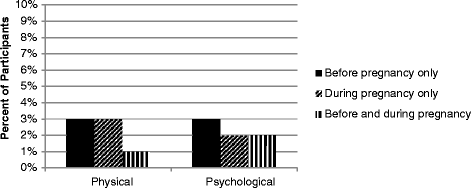Risk of violence from the man involved in the pregnancy after receiving or being denied an abortion
- PMID: 25262880
- PMCID: PMC4182793
- DOI: 10.1186/s12916-014-0144-z
Risk of violence from the man involved in the pregnancy after receiving or being denied an abortion
Abstract
Background: Intimate partner violence is common among women having abortions, with between 6% and 22% reporting recent violence from an intimate partner. Concern about violence is a reason some pregnant women decide to terminate their pregnancies. Whether risk of violence decreases after having an abortion, remains unknown.
Methods: Data are from the Turnaway Study, a prospective cohort study of women seeking abortions at 30 facilities across the U.S. Participants included women who: presented just prior to a facility's gestational age limit and received abortions (Near Limit Abortion Group, n = 452), presented just beyond the gestational limit and were denied abortions (Turnaways, n = 231), and received first trimester abortions (First Trimester Abortion Group, n = 273). Mixed effects logistic regression was used to assess the relationship between receiving versus being denied abortion and subsequent violence from the man involved in the pregnancy over 2.5 years.
Results: Physical violence decreased for Near Limits (adjusted odds ratios (aOR), 0.93 per month; 95% Confidence Interval (CI) 0.90, 0.96), but not Turnaways who gave birth (P < .05 versus Near Limits). The decrease for First Trimesters was similar to Near Limits (P = .324). Psychological violence decreased for all groups (aOR, 0.97; CI 0.94, 1.00), with no differential change across groups.
Conclusions: Policies restricting abortion provision may result in more women being unable to terminate unwanted pregnancies, potentially keeping them in contact with violent partners, and putting women and their children at risk.
Figures
References
-
- Pallitto CC, Garcia-Moreno C, Jansen HA, Heise L, Ellsberg M, Watts C. Intimate partner violence, abortion, and unintended pregnancy: results from the WHO multi-country study on women’s health and domestic violence. Int J Gynaecol Obstet. 2013;120:3–9. doi: 10.1016/j.ijgo.2012.07.003. - DOI - PubMed
Publication types
MeSH terms
LinkOut - more resources
Full Text Sources
Other Literature Sources
Medical



